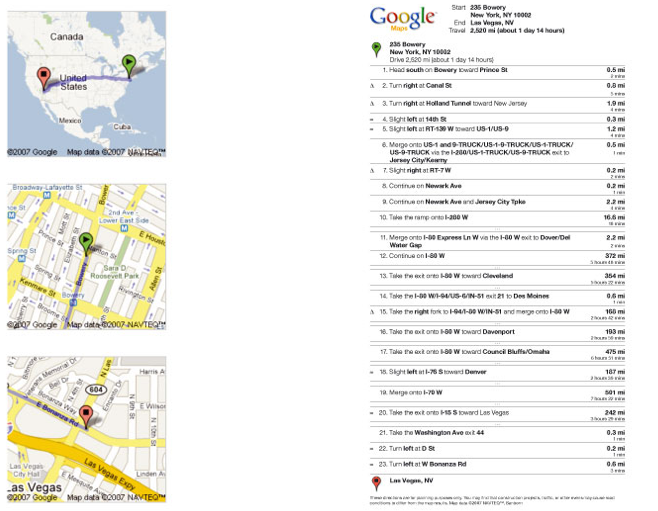1. NOTE ON MOVEMENT
–SPACE: the changing domain of thinking resulting from the development of new
kinds of spatial awareness - By Nigel Thrift
‘Qualculative’ world and representation
According to Nigel Thrift the transition from a calculative
world to what he defines as a ‘qualculative’ world is producing a new sense of
space. But what is surprising for me is that this new sense of space for Thrift
is manifesting itself more as unconscious reactions then new kinds of conscious
representation or practices.
It seems that this new sense of movement-space will or is emerging as symptoms to be found in mental conditions as anxieties and phobia; or in new form of intuition.
Since Thrift tries to make a historical parallel between the abstractions (Discovery of mathematical deduction, Identification of the population as a thinkable entity, Grid of time and space, Invention of filing and listing system, Invention of logistic) that produced a new sense of the world and new representation of it, and what is happening now, I’m wondering: what kind of representation the ‘qualculative’ world will create of itself?
It seems that this new sense of movement-space will or is emerging as symptoms to be found in mental conditions as anxieties and phobia; or in new form of intuition.
Since Thrift tries to make a historical parallel between the abstractions (Discovery of mathematical deduction, Identification of the population as a thinkable entity, Grid of time and space, Invention of filing and listing system, Invention of logistic) that produced a new sense of the world and new representation of it, and what is happening now, I’m wondering: what kind of representation the ‘qualculative’ world will create of itself?
Reading through the text and in particular thinking about
this new kind of representation two art pieces came into my mind that both deal
with map and representation of space:
1. ART & LANGUAGE. Michael BALDWIN & Terry
ATKINSON: Map of an area of dimensions 12" x 12" indicating 2,304 1/4
inches. (Map of itself). 1967.
2. New York – Las Vegas«, 2007, by Cory Arcangel,
instructs viewers on the easiest way to leave Manhattan behind and spend a
weekend in Las Vegas. Using Google maps, he describes the fastest route from
the Bowery to the nearest Vegas casino.
2. NOTES ON DISJUNCTURE AND
DIFFERENCE IN THE GLOBAL CULTURAL ECONOMY
The most interesting part of this text from my perspective
is how Arjun Appadurai identifies the new role of imagination in social life.
“The image, the imagined, the imaginary direct us to something new in global cultural process: the imagination as a social practice”.
Is interesting how what as been considered as the domain of Art, and then Culture Industries, can now been considered as a social practice.
Artist, Cultural industries or Governments are now just nodes of a complex transnational construction of imaginary landscape that have many contributor and became essential to find and define the relationship between reality and appearance, the individual and the collective.
All this make me think about the role of fiction in Art that Jacques Rancière tries to define on the essay ‘The paradoxes of political art’.
“ Within any given framework, artists are those whose strategies aim to change the frame, speeds and scale according to which we perceive the visible and combine it with a specific visible element and a specific meaning. Such strategies are intended to make the invisible visible or to question the self-evidence of the visible; to rupture given relation between things and meaning and, inversely, to invent novel relationship between things and meaning that were previously unrelated. This might be called the labor of fiction, which, in my view, is a word that we need to re-conceive. Fiction, as re-framed by the aesthetic regime of art, means far more than the constructing of an imaginary as opposed to the real; it involves the re-framing of the real, or the framing of dissensus. Fiction is a way of changing existing modes of sensory presentation and forms of enunciation; of varying frames, scales and rhythms; and of building new relationship between reality and appearance, the individual and the collective.”
“The image, the imagined, the imaginary direct us to something new in global cultural process: the imagination as a social practice”.
Is interesting how what as been considered as the domain of Art, and then Culture Industries, can now been considered as a social practice.
Artist, Cultural industries or Governments are now just nodes of a complex transnational construction of imaginary landscape that have many contributor and became essential to find and define the relationship between reality and appearance, the individual and the collective.
All this make me think about the role of fiction in Art that Jacques Rancière tries to define on the essay ‘The paradoxes of political art’.
“ Within any given framework, artists are those whose strategies aim to change the frame, speeds and scale according to which we perceive the visible and combine it with a specific visible element and a specific meaning. Such strategies are intended to make the invisible visible or to question the self-evidence of the visible; to rupture given relation between things and meaning and, inversely, to invent novel relationship between things and meaning that were previously unrelated. This might be called the labor of fiction, which, in my view, is a word that we need to re-conceive. Fiction, as re-framed by the aesthetic regime of art, means far more than the constructing of an imaginary as opposed to the real; it involves the re-framing of the real, or the framing of dissensus. Fiction is a way of changing existing modes of sensory presentation and forms of enunciation; of varying frames, scales and rhythms; and of building new relationship between reality and appearance, the individual and the collective.”


No comments:
Post a Comment